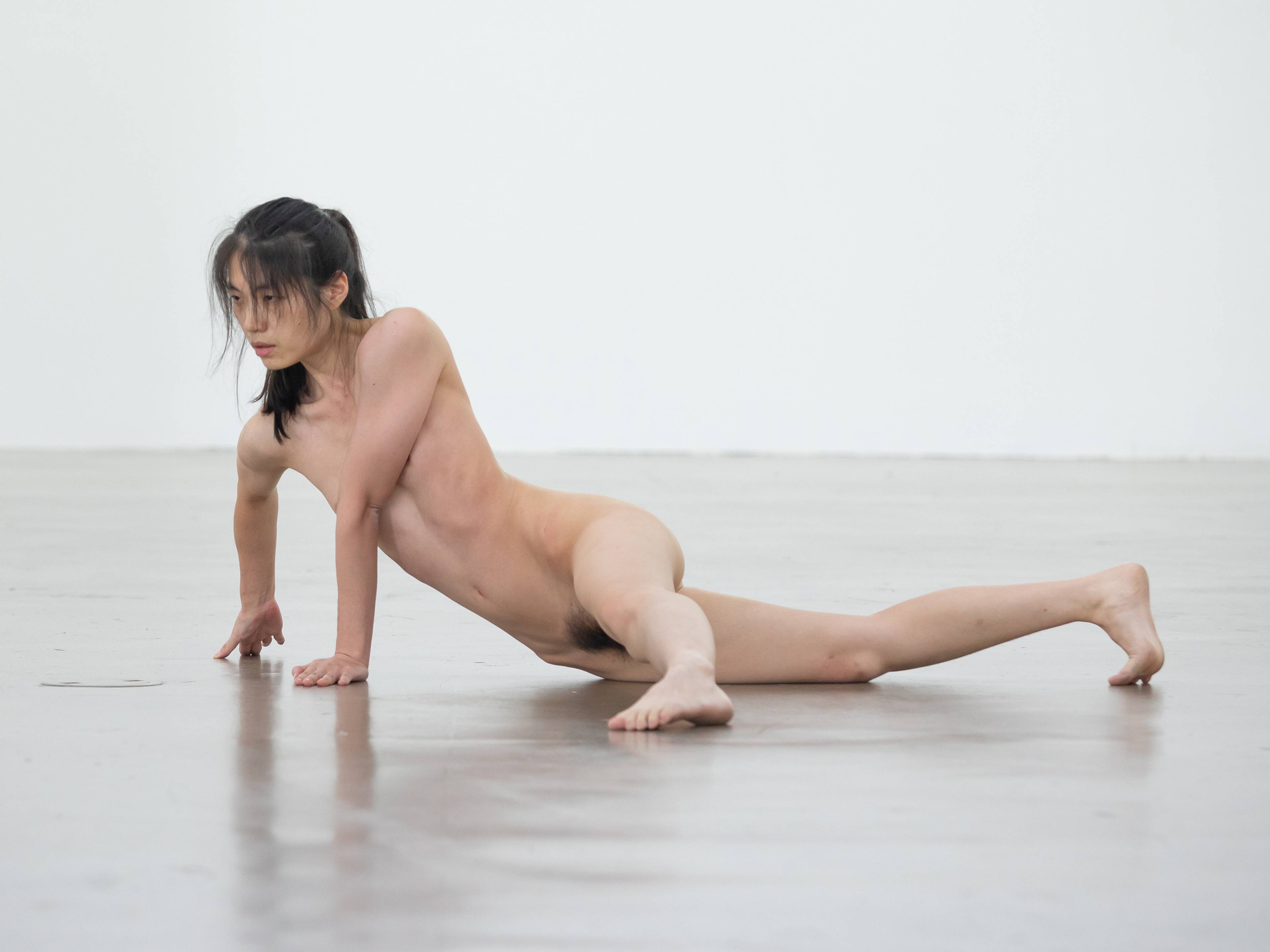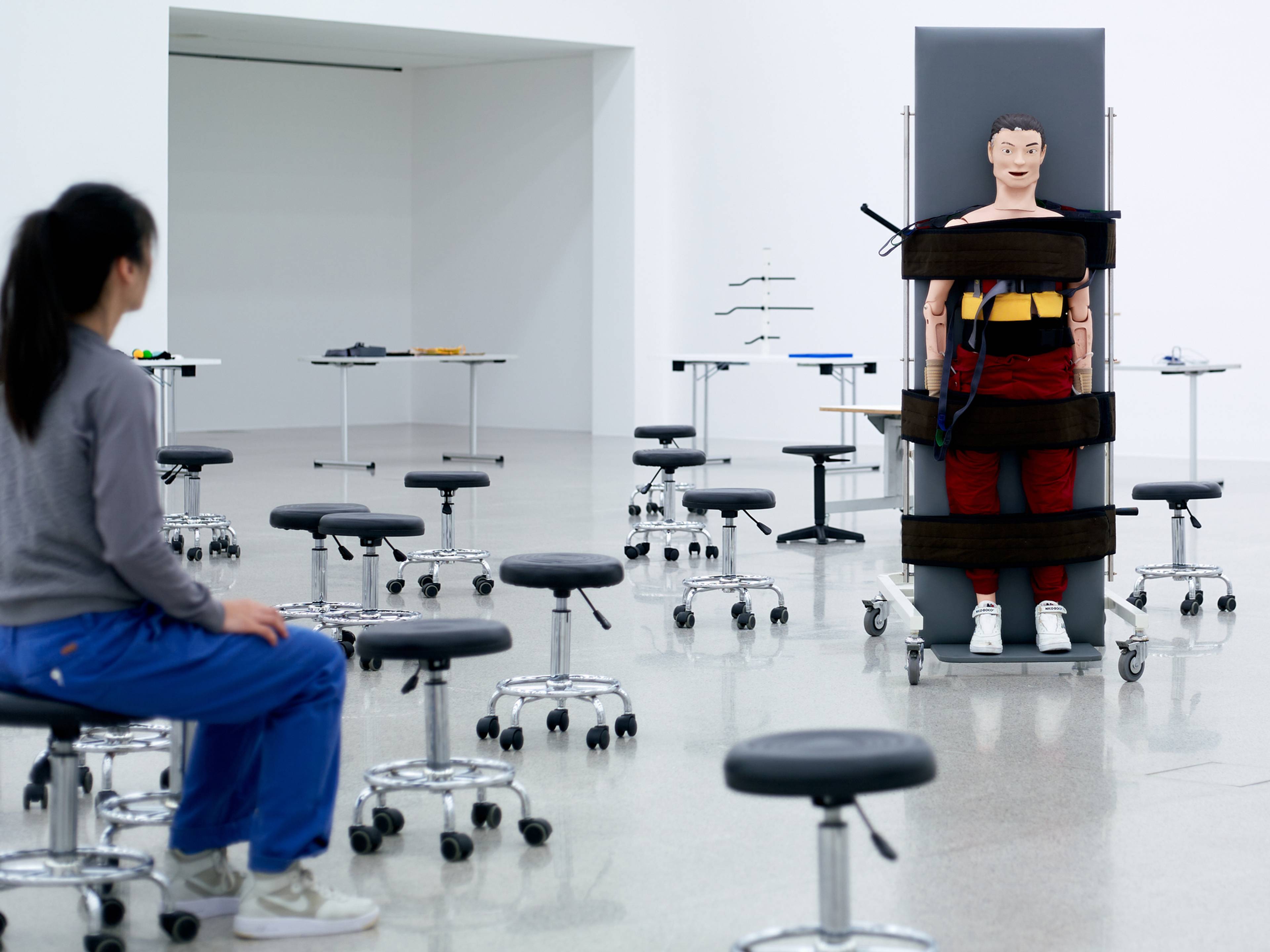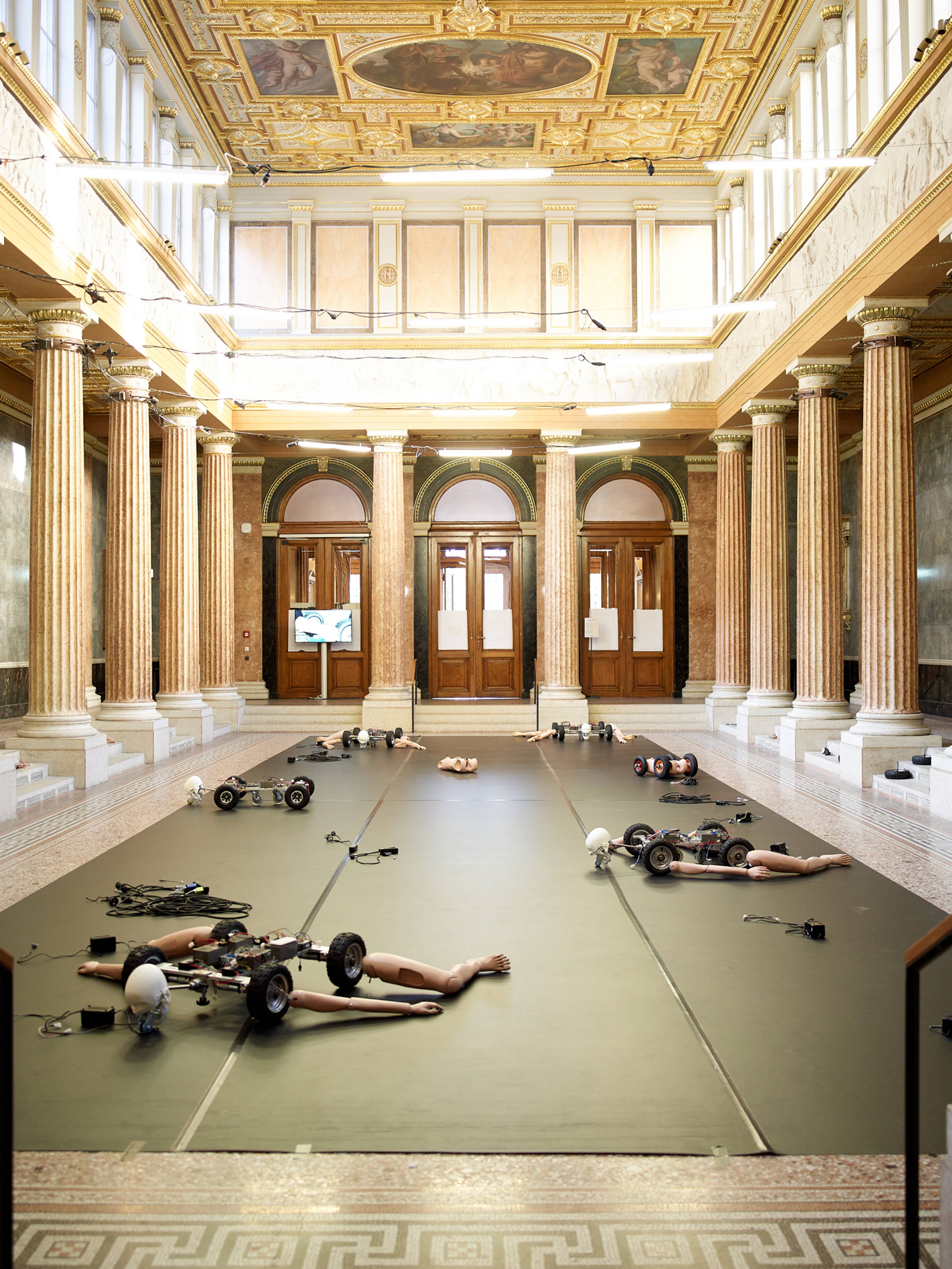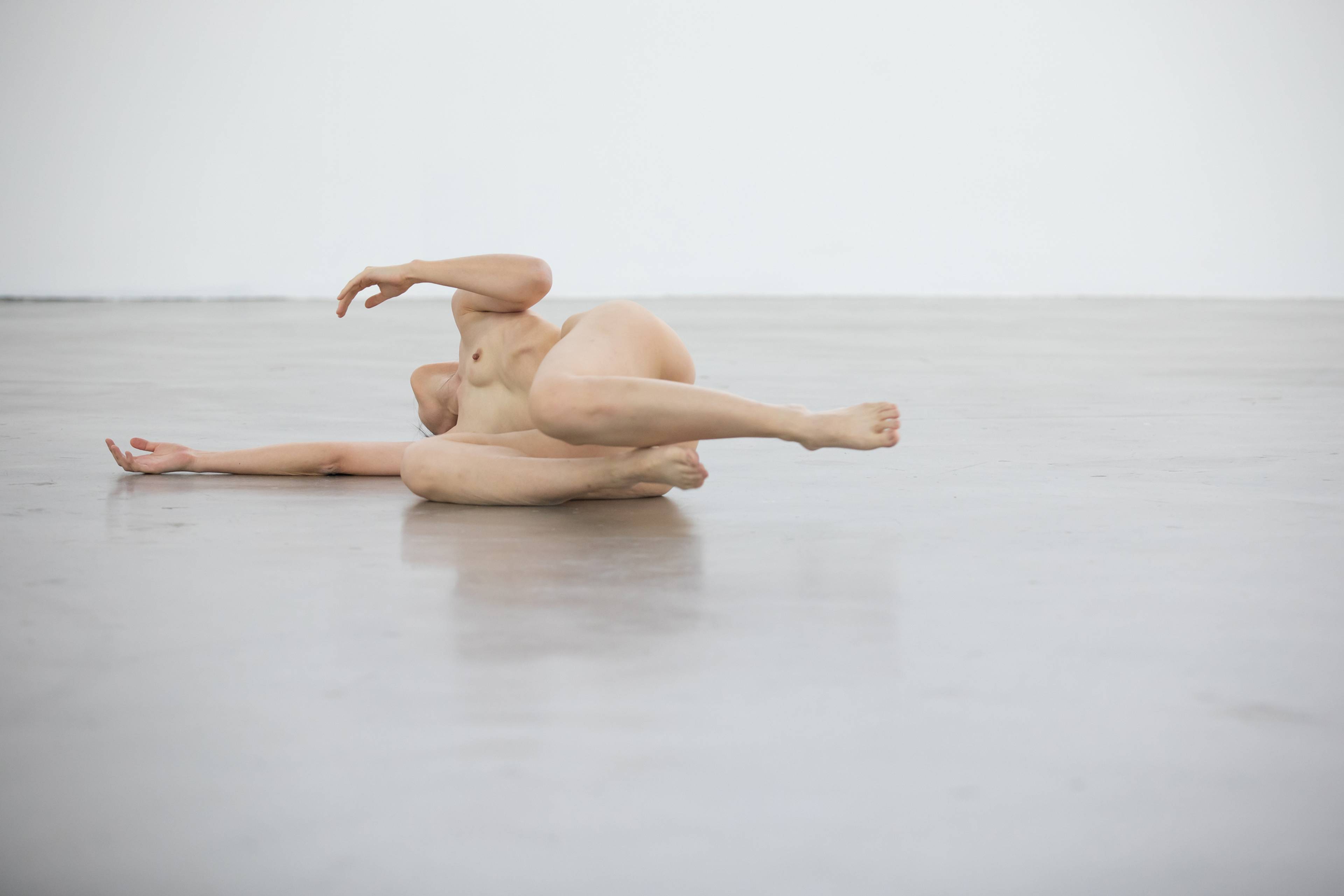Over the past decade, the work of Geumhyung Jeong has sensually engaged with robots. She has continuously taken them apart, exhibited their fragments, and put them back together to build her own machines. In 2022, the South Korean artist presented three works at Vienna’s international dance festival, ImPulsTanz, that focused on the relationships between material objects, her own body, and the bodies of her viewers. This year, she is back with Find, Select, Copy and Paste (2020), a performance in which Jeong presents her own body as the object and sole protagonist.
Lisa Moravec: I saw first your work in London in 2017, first in an installation of robotic objects at the Delfina Foundation, then in your installation and live performance at Tate Modern [7ways]. I became interested in your performative practice of collecting, arranging, and taking care of these somehow bizarre objects. The way you presented them alienated them from their quotidian use value. In the performance you’re showing at ImPulsTanz this year, it’s just going to be you naked onstage, without any objects. How come?
Geumhyung Jeong: The bodily movements in most of my previous performances had a very clear purpose: I tried to make objects move by themselves, as if they were alive. The objects should have been more visible than me, and I tried to disappear from the viewer’s attention. I would say I have developed my own technique for moving objects like a puppeteer.
Find, Select, Copy and Paste is about choosing and rearranging the movements I have created for objects, and then performing them without. It is like removing them from their contexts and seeing the pure movement of the body itself as a choreography. This work can be compared to the Delfina exhibition, where the objects from my performances were installed without my body. They were arranged according to their own nature, as pure objects, and presented without the context that I had collected them for performances.
View of Geumhyung Jeong, “Private Collection: Unperformed Objects,” 2017, Delfina Foundation, London. Photo: Dan Weill
Geumhyung Jeong, 7Ways, 2009. Installation view, Tate Modern, London, 2017. © Tate Photography. Photo: Alex Wojcik
LM: What movements are you showing in this piece, and how do you use your body?
GJ: The movements in Find, Select, Copy and Paste come from my other works, and the key process here was to select and put them together. I edited the movements so that they flow together naturally and tried to find an order that makes sense. Some of them would be recognizable to people familiar with my performances; others wouldn’t be recognizable at all without the absent objects, whether you’ve seen the original piece or not.
LM: What makes this performance distinct from your previous works?
GJ: Some of the selected movements can remain the same without the objects, but others cannot. I made the decision that it should be visually different for the audience, whereas my experience on the stage as a performer is much the same, as I often use my body like one of the objects.
LM: Has the absence of machines in the working process changed your approach to the body and choreography?
GJ: Not really.
I have often thought performing onstage is like becoming a victim of a ritual. So, I think nakedness suits performances in some contexts where we can realize the body itself is a material.
LM: It’s interesting to see that your current piece approaches the body-mind and choreographer-engineer problem by returning to purely corporeal performance, where the body expresses its aesthetics through the quality of its movement, rather than in relation to real objects. Did you do away with inanimate objects to explicitly focus on the body?
GJ: I like this contrast. After showing my vast collection of objects and expanding the series of robotic sculptures over time as installations, my work got bigger and [literally] heavier. Then, I suddenly came up with the idea to show just a body. I use nakedness in this piece to emphasize that there are no objects, that the body is the only object.
LM: What role does the representation of gender play in your work? Does it make a difference to you when you perform, as an Asian woman, naked and all by yourself on the stage, or when you perform with apparently neutral objects?
GJ: Being naked on the stage is like wearing the costume of nakedness. I guess it is different from being naked on the street, in the metro, or in any kind of public place. Doing something onstage, in front of people, feels like being naked anyway, and in Find, Select, Copy and Paste, I am literally naked. I have often thought performing onstage is like becoming a victim of a ritual. So, I think nakedness suits performances in some contexts where we can realize the body itself is a material. When I’m onstage, I can forget that I am naked because I do not see myself and I am busy with the task at hand; only when I see a photo or video documentation of my performances later do I realize how naked I was.
Geumhyung Jeong, Find, Select, Copy and Paste, 2020. Performance view, Art Sonje Centre, South Korea. © Haewook Park
LM: Is this somehow a return to your initial approach to art-making? You also studied acting and film animation.
GJ: I would say that I have never left these practices. Even though they are not onstage anymore, Find, Select, Copy and Paste still deals with objects – just by resort to historical relationships in my work.
LM: Why did you initially become interested in robots?
GJ: I began to be interested in controlling an object from a distance, in remote controllers, and in the triangular relationship between a remote controller, the controlled object, and the person controlling the object.
LM: How would you describe your approach to performance-making and technology, and the relation between bodies and machines?
GJ: Puppetry.
LM: In Rehab Training [2022], you developed your own manner of interacting with dummies used in medical education. Did this work come about as a collaboration with medical technology and science? Or was this something you developed on your own, using your self-made robots?
GJ: I read books about rehabilitation and occupational therapy and looked into what products I could buy for the task I wanted to execute with the dummy. Then, I adapted how these rehabilitation products are used for my particular artistic purpose.
Geumhyung Jeong, Rehab Training, 2015. Performance view, mumok, ImpulsTanz, Vienna, 2022. Photo: Peter Mayr
Geumhyung Jeong, Homemade RC Toy, 2019. Installation view, Akademie der bildenden Künste Wien, ImpulsTanz, Vienna, 2022. Photo: Peter Mayr
LM: The development of robots in medicine, the automation of specific, task-based jobs, and the increasing production of embodied AI have led to many collaborations between dance and science. Is this something you are interested in?
GJ: Maybe not really in the form of a collaboration, but I might learn things from scientists.
LM: Are you going to continue collecting and working with robotic objects in the future, or do you think you will focus more on the complex psycho-physical aspects of working directly with the body?
GJ: [Laughing] I don’t really know what the meaning of “the complex psycho-physical aspects of working with the body” means, but I like your expression. Yes, I am going to continue with my practice of collecting, arranging, and taking care of these objects.
Geumhyung Jeong, Find, Select, Copy and Paste, 2020. Performance view, Art Sonje Centre, South Korea. © Haewook Park
___
Find, Select, Copy and Paste
mumok, Vienna
24 July & 26 July at 18h
“Under Construction”
ICA, London
24 Sep – 8 Dec








